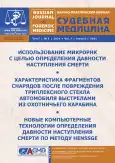Characteristics of shell fragments after hitting triplex car glass with shots from a hunting “Saiga” carbine under the 5.45×39 cartridge
- Authors: Leonov S.V.1,2, Pinchuk P.V.1,3, Suhareva M.A.2, Shakiryanova J.P.1,2
-
Affiliations:
- Main State Center for Medical Forensic and Criminalistical Examination
- Moscow State University of Medicine and Dentistry named after A.I. Evdokimov
- The Russian National Research Medical University named after N.I. Pirogov
- Issue: Vol 7, No 3 (2021)
- Pages: 139-145
- Section: Original study articles
- URL: https://journals.rcsi.science/2411-8729/article/view/122409
- DOI: https://doi.org/10.17816/fm381
- ID: 122409
Cite item
Full Text
Abstract
Background: The article aims to assess the possibilities of innovative research methods in scanning electron microscopy (SEM) with energy dispersion analysis (EDS) forensic medicine. The described methods were used in experimental studies of a gunshot retrograde injury. Aim: The purpose of this study was to evaluate the particles formed during the destruction of a semi-shell shell and an obstacle (triplex car glass) when fired from a hunting Saiga carbine with 5.45×39 cartridges. Material and methods: Triplex windshields from BMW and Mercedes-Benz cars were used as barriers. The shots were fired from a hunting Saiga carbine with a 5.45×39 cartridge from a distance of 10 m. As targets, white calico with dimensions of 100×150 cm was used, while stretched on a wooden frame or fixed on a chipboard. The distance between the target and the barrier was 100 cm, which approximately corresponded to the distance from the car windshield to the driver and the passenger in the front seat. The studies were conducted using the SEM Hitachi FlexSem1000 II and the energy-dispersive X-ray spectrometer Bruker Quantax 80. Results: Microscopy helped identify seven types of foreign bodies on the surface of the target, which were the products of destruction of the fire projectile and the barrier: glass fragments, glass fragments, crumbly depositions of glass particles, glass fragments caked with the projectile metal, fragments of the projectile, spherical metal particles, and overlays of molten metal in the form of puddles. EDS helped determine the elemental composition of the barrier particles, fire shell, and the overlap of target particles. Conclusion. The experimental study demonstrated that the use of SEM and EDS significantly increased the effectiveness and evidence-based expert research value while solving the problems of causing damage through the barrier-the windscreen of modern cars.
Full Text
##article.viewOnOriginalSite##About the authors
Sergey V. Leonov
Main State Center for Medical Forensic and Criminalistical Examination; Moscow State University of Medicine and Dentistry named after A.I. Evdokimov
Author for correspondence.
Email: sleonoff@inbox.ru
ORCID iD: 0000-0003-4228-8973
SPIN-code: 2326-2920
MD, Dr. Sci. (Med.), Professor
Russian Federation, 3 Hospitalnaya Square, Moscow, 105094; MoscowPavel V. Pinchuk
Main State Center for Medical Forensic and Criminalistical Examination; The Russian National Research Medical University named after N.I. Pirogov
Email: pinchuk1967@mail.ru
ORCID iD: 0000-0002-0223-2433
SPIN-code: 7357-3038
MD, Dr. Sci. (Med.), Assistant Professor, Professor
Russian Federation, 3 Hospitalnaya Square, Moscow, 105094; MoscowMarina A. Suhareva
Moscow State University of Medicine and Dentistry named after A.I. Evdokimov
Email: ma-suha@yandex.ru
ORCID iD: 0000-0003-3422-6043
MD, Cand. Sci. (Med.)
Russian Federation, 3 Hospitalnaya Square, Moscow, 105094Juliya P. Shakiryanova
Main State Center for Medical Forensic and Criminalistical Examination; Moscow State University of Medicine and Dentistry named after A.I. Evdokimov
Email: tristeza_ul@mail.ru
ORCID iD: 0000-0002-1099-5561
SPIN-code: 1429-6230
MD, Cand. Sci. (Med.), Assistant Professor
Russian Federation, 3 Hospitalnaya Square, Moscow, 105094; MoscowReferences
- Fedorenko VA, Pereverzev MM. Features of establishing the place of the shot when the projectile penetrates some transparent materials. Expert criminalist. 2007;(3):10–14. (In Russ).
- Pinchuk PV, Shakiryanova JP, Leonov SV, Vereskunov AM. Features of the morphology and mechanism of formation of output gunshot injuries with the diligence to them of a solid barrier. Military Medical Journal. 2019;340(6):28–32. (In Russ).
- Knoll M, Ruska E. Das elektronenmikroskop. Zeitschrift für Physik A Hadrons and Nuclei. 1932;78(5-6):318–339. doi: 10.1007/BF01342199
- Von Ardenne M. Das elektronen-rastermikroskop. Zeitschrift für Physik A Hadrons and Nuclei. 1938;108(9-10):553–572. doi: 10.1007/BF01341584
- Gouldstejn Dzh, N'yuberi D, Echlin P, et al. Scanning electron microscopy and X-ray microanalysis. Moscow: Mir; 1984. 303 р. (In Russ).
Supplementary files














